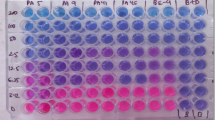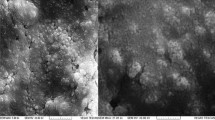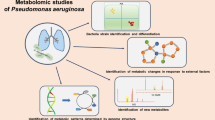Abstract
SERS spectra of 12 bacterial strains of urinary tract infection (UTI) clinical isolates grown and enriched from urine are reported. A partial least squares-discriminant analysis (PLS-DA) classification treatment of these SERS spectra results in strain level identification with >95% sensitivity and >99% specificity. The classification model successfully identified the SERS spectra of a urine-cultured strain not used to build this statistical model. Enrichment was accomplished by a filtration and centrifugation protocol. The predetermined drug susceptibility profiles of these clinical isolates thus allowed the SERS methodology to provide appropriate UTI antibiotic information in less than 1 h. Most of this time was used for sample preparation procedures (enrichment and washing) for this proof of principle study. SERS spectra of the enriched bacterial samples are dominated by nucleotide degradation metabolites: adenine, hypoxanthine, xanthine, guanine, uric acid, AMP, and guanosine. Strain-specific specificity is due to the different relative amounts of these purines contributing to the corresponding SERS spectra of these clinical isolates. All measurements were made at the minimal bacterial concentration in urine for UTI diagnosis (105 cfu/mL).

The relative contribution of each of the seven purines found to contribute to the bacterial SERS spectra are summarized in this bar graph. Although strain specific differences are evident, it can be see how the pattern of contributing purines is more different between the four species than between strains of a given species








Similar content being viewed by others
References
Caliendo AM, Gilbert DN, Ginocchio CC, Hanson KE, May L, Quinn TC, et al. Better tests, better care: improved diagnostics for infectious diseases. Clin Infect Dis: Off Publ Infect Dis Soc Am. 2013;57 Suppl 3:S139–S70.
Foxman B. Urinary tract infection syndromes: occurrence, recurrence, bacteriology, risk factors, and disease burden. Infect Dis Clin N Am. 2014;28(1):1–13.
Schmiemann G, Kniehl E, Gebhardt K, Matejczyk MM, Hummers-Pradier E. The diagnosis of urinary tract infection: a systematic review. Dtsch Arztebl Int. 2010;107(21):361–7.
Foxman B. Epidemiology of urinary tract infections: incidence, morbidity, and economic costs. Dis Mon. 2003;49(2):53–70.
Schappert SM, Rechtsteiner EA. Ambulatory medical care utilization estimates for 2006. National health statistics reports; no 8, Hyattsville, MD: National Center for Health Statistics. 2008.
Griebling TL. Urinary tract infection in women. In: Litwin MS, Saigal CS, editors. Urologic diseases in America. NIH publication 07–5512. Washington, D.C.: Department of Health and Human Services, Public Health Service, National Institutes of Health, National Institute of Diabetes and Digestive and Kidney Diseases; 2007. p. 587–619.
Schappert SM. Ambulatory care visits of physician offices, hospital outpatient departments, and emergency departments: United States, 1995. Vital and health statistics Series 13, Data from the National Health Survey. 1997(129):1–38.
Wilson ML, Gaido L. Laboratory diagnosis of urinary tract infections in adult patients. Clin Infect Dis. 2004;38(8):1150–8.
Hooton TM, Stamm WE. Diagnosis and treatment of uncomplicated urinary tract infection. Infect Dis Clin N Am. 1997;11(3):551–81.
Dason S, Dason JT, Kapoor A. Guidelines for the diagnosis and management of recurrent urinary tract infection in women. Can Urol Assoc J. 2011;5:316–22.
Franz M, Hörl WH. Common errors in diagnosis and management of urinary tract infection. I: pathophysiology and diagnostic techniques. Nephrol Dial Transplant. 1999;14(11):2746–53.
Hooton TM, Bradley SF, Cardenas DD, Colgan R, Geerlings SE, Rice JC, et al. Diagnosis, prevention, and treatment of catheter-associated urinary tract infection in adults: 2009 International Clinical Practice Guidelines from the Infectious Diseases Society of America. Clin Infect Dis. 2010;50(5):625–63.
Gupta K, Bhadelia N. Management of urinary tract infections from multidrug-resistant organisms. Infect Dis Clin N Am. 2014;28(1):49–59.
Kahlmeter G. An international survey of the antimicrobial susceptibility of pathogens from uncomplicated urinary tract infections: the ECO·SENS Project. J Antimicrob Chemother. 2003;51(1):69–76.
Extended-spectrum beta-lactamases [Internet]. Wolters Kluwer. 2013. Available from: http://www.uptodate.com/contents/extended-spectrum-beta-lactamases.
Yang S, Rothman RE. PCR-based diagnostics for infectious diseases: uses, limitations, and future applications in acute-care settings. Lancet Infect Dis. 2004;4(6):337–48.
Fredricks DN, Relman DA. Application of polymerase chain reaction to the diagnosis of infectious diseases. Clin Infect Dis. 1999;29(3):475–88.
Andreotti PE, Ludwig GV, Peruski AH, Tuite JJ, Morse SS, Peruski Jr LF. Immunoassay of infectious agents. BioTechniques. 2003;34(4):850–9.
Weile J, Knabbe C. Current applications and future trends of molecular diagnostics in clinical bacteriology. Anal Bioanal Chem. 2009;394(3):731–42.
Mach K, Wong PK, Liao JC. Biosensor diagnosis of urinary tract infections: a path to better treatment? Trends Pharmacol Sci. 2011;32:330–6.
Finch R. Regulatory opportunities to encourage technology solutions to antibacterial drug resistance. J Antimicrob Chemother. 2011;66(9):1945–7.
Efrima S, Bronk BV. Silver colloids impregnating or coating bacteria. J Phys Chem B. 1998;102:5947–50.
Guzelian AA, Sylvia JM, Janni J, Clauson SL, Spenser KM. SERS of whole cell bacteria and trace levels of biological molecules. Proc SPIE. 2002;4577:182–92.
Jarvis RM, Brooker A, Goodacre R. Surface-enhanced Raman scattering for the rapid discrimination of bacteria. Faraday Discuss. 2006;132:281–92. discussion 309–19.
Premasiri WR, Moir DT, Klempner MS, Krieger N, Jones II G, Ziegler LD. Characterization of the surface enhanced Raman scattering (SERS) of bacteria. J Phys Chem B. 2005;109:312–20.
Sengupta A, Mujacic M, Davis EJ. Detection of bacteria by surface-enhanced Raman spectroscopy. Anal Bioanal Chem. 2006;386:1379–86.
Zeiri L, Efrima S. Surface-enhanced Raman spectroscopy of bacteria: the effect of excitation wavelength and chemical modification of the colloidal milieu. J Raman Spectrosc. 2005;36:667–75.
Kahraman M, Yazici MM, Sahin F, Bayrak OF, Culha M. Reproducible surface-enhanced Raman scattering spectra of bacteria on aggregated silver nanoparticles. Appl Spectrosc. 2007;61(5):479–85.
Chu H, Huang Y, Zhao Y. Silver nanorod arrays as a surface-enhanced Raman scattering substrate for foodborne pathogenic bacteria detection. Appl Spectrosc. 2008;62:922–31.
Liu T-T, Lin Y-H, Hung C-H, Liu T-J, Chen Y, Huang Y-C, et al. A high speed detection platform based on surface-enhanced Raman scattering for monitoring antibiotic-induced chemical changes in bacteria cell wall. PLoS ONE. 2009;4(5), e5470.
Zhou H, Yang D, Ivleva NP, Mircescu NE, Niessner R, Haisch C. SERS detection of bacteria in water by in situ coating with Ag nanoparticles. Anal Chem. 2014;86(3):1525–33.
Jarvis RM, Goodacre R. Discrimination of bacteria using surface-enhanced Raman spectroscopy. Anal Chem. 2004;76(1):40–7.
Jarvis RM, Goodacre R. Characterisation and identification of bacteria using SERS. Chem Soc Rev. 2008;37(5):931–6.
Kastanos E, Hadjigeorgiou K, Kyriakides A, Pitris C. Classification of bacterial samples as negative or positive for a UTI and antibiogram using surface enhanced Raman spectroscopy. Proc SPIE. 2011;7911:791107–6.
Kastanos E, Kyriakides A, Hadjigeorgiou K, Pitris C. A novel method for bacterial UTI diagnosis using Raman spectroscopy. International Journal of Spectroscopy. 2012;2012.
Hadjigeorgioua K, Kastanosb E, Kyriakidesa A, Pitris C. Complete urinary tract infection (UTI) diagnosis and antibiogram using surface enhanced Raman spectroscopy (SERS). SPIE Proceed. 2012;8229:82290D-1-7.
Mircescu NE, Zhou H, Leopold N, Chiş V, Ivleva NP, Niessner R, et al. Towards a receptor-free immobilization and SERS detection of urinary tract infections causative pathogens. Anal Bioanal Chem. 2014;406(13):3051–8.
Avci E, Kaya NS, Ucankus G, Culha M. Discrimination of urinary tract infection pathogens by means of their growth profiles using surface enhanced Raman scattering. Anal Bioanal Chem. 2015;407(27):8233–41.
Goodacre R, Timmins ÉM, Burton R, Kaderbhai N, Woodward AM, Kell DB, et al. Rapid identification of urinary tract infection bacteria using hyperspectral whole-organism fingerprinting and artificial neural networks. Microbiology. 1998;144(5):1157–70.
Kastanos EK, Kyriakides A, Hadjigeorgiou K, Pitris C. A novel method for urinary tract infection diagnosis and antibiogram using Raman spectroscopy. J Raman Spectrosc. 2010;41(9):958–63.
Kloß S, Kampe B, Sachse S, Rösch P, Straube E, Pfister W, et al. Culture independent Raman spectroscopic identification of urinary tract infection pathogens: a proof of principle study. Anal Chem. 2013;85(20):9610–6.
Premasiri WR, Moir DT, Klempner MS, Ziegler LD. Surface enhanced Raman scattering of microorganisms. In: Kneipp K, Aroca R, Kneipp H, Wentrup-Byrne E, editors. New approaches in biomedical spectroscopy. New York: Oxford University Press; 2007. p. 164.
Premasiri WR, Gebregziabher Y, Ziegler LD. On the difference between surface-enhanced Raman scattering (SERS) spectra of cell growth media and whole bacterial cells. Appl Spectrosc. 2011;65(5):493–9.
Premasiri WR, Moir DT, Ziegler LD. Vibrational fingerprinting of bacterial pathogens by surface enhanced Raman scattering. SPIE. 2005;5795.
Patel IS, Premasiri WR, Moir DT, Ziegler LD. Barcoding bacterial cells: a SERS based methodology for pathogen identification. J Raman Spectrosc. 2008;39(11):1660–72.
Boardman AK, Wong WS, Premasiri WR, Ziegler LD, Lee JC, Miljkovic M, et al. Rapid detection of bacteria from blood with surface-enhanced Raman spectroscopy. Anal Chem. 2016;88(16):8026–35.
Premasiri WR, Lee JC, Sauer-Budge A, Théberge R, Costello CE, Ziegler LD. The biochemical origins of the surface-enhanced Raman spectra of bacteria: a metabolomics profiling by SERS. Anal Bioanal Chem. 2016;408(17):4631–47.
Ranghino A, Dimuccio V, Papadimitriou E, Bussolati B. Extracellular vesicles in the urine: markers and mediators of tissue damage and regeneration. Clin Kidney J. 2015;8(1):23–30.
Premasiri WR, Sauer-Budge AF, Lee JC, Klapperich CM, Ziegler LD. Rapid bacterial diagnostics via surface enhanced Raman microscopy. Spectroscopy. 2012(June):40–9.
Premasiri WR, Lemler P, Chen Y, Gebregziabher Y, Ziegler LD. SERS analysis of bacteria, human blood and cancer cells: a metabolomic and diagnostic tool. In: Ozaki Y, Kneipp K, Aroca R, editors. Frontiers of surface-enhanced Raman scattering: single-nanoparticles and single cells. Chichester: Wiley & Sons; 2014. p. 255–82.
Efrima S, Zeiri L. Understanding SERS of bacteria. J Raman Spectrosc. 2009;40(3):277–88.
Maharjan RP, Ferenci T. Metabolomic diversity in the species Escherichia coli and its relationship to genetic population structure. Metabolomics. 2005;1(3):235–42.
Acknowledgements
We thank BD Life Sciences for providing the clinical isolates used in this study and for running the antimicrobial susceptibility testing on these clinical isolates (BD and BD Phoenix are trademarks of Becton, Dickinson and Company. © 2016 BD). The support of the NSF I/UCRC Collaborative Research Award Grant# 1068070 is gratefully acknowledged.
Author information
Authors and Affiliations
Corresponding authors
Ethics declarations
We state that all anonymized urine samples were collected from individual participants who were informed and voluntarily participated in this research work in accordance with Boston University ethical guidelines and relevant IBC protocols.
Conflict of interest
The authors declare that they have no conflicts of interest.
Electronic supplementary material
Below is the link to the electronic supplementary material.
ESM 1
(PDF 3063 kb)
Rights and permissions
About this article
Cite this article
Premasiri, W.R., Chen, Y., Williamson, P.M. et al. Rapid urinary tract infection diagnostics by surface-enhanced Raman spectroscopy (SERS): identification and antibiotic susceptibilities. Anal Bioanal Chem 409, 3043–3054 (2017). https://doi.org/10.1007/s00216-017-0244-7
Received:
Revised:
Accepted:
Published:
Issue Date:
DOI: https://doi.org/10.1007/s00216-017-0244-7




